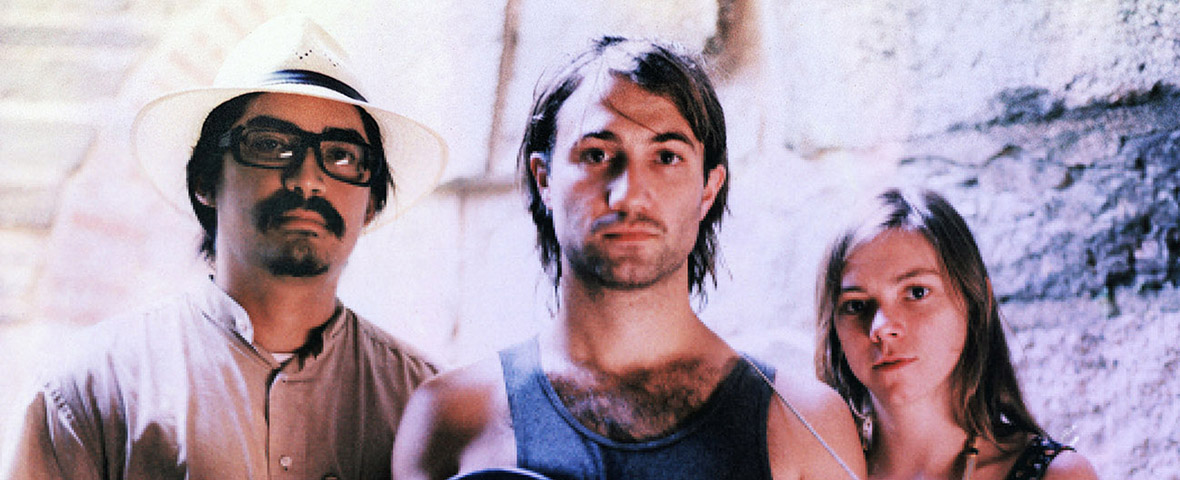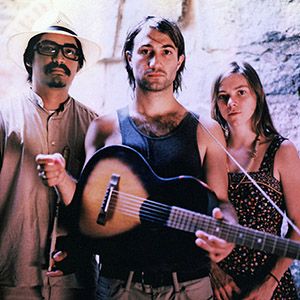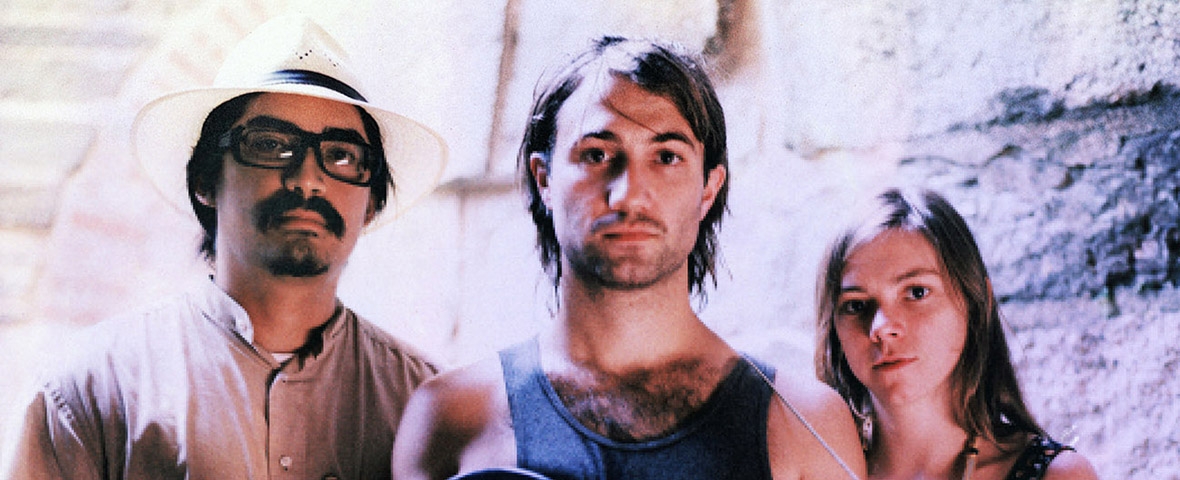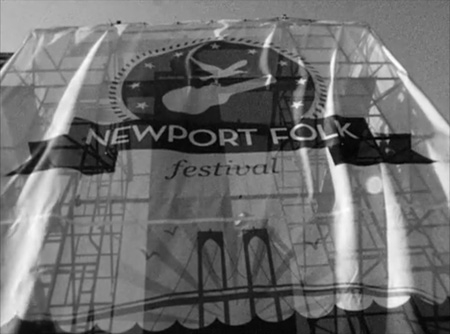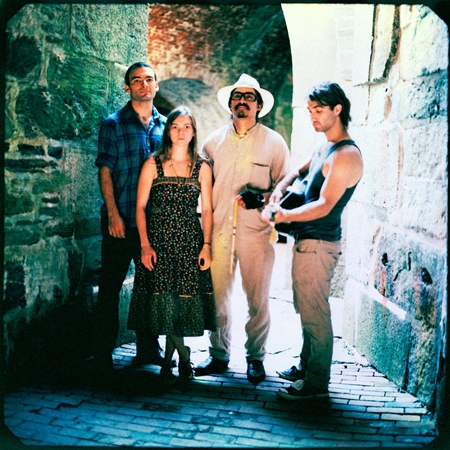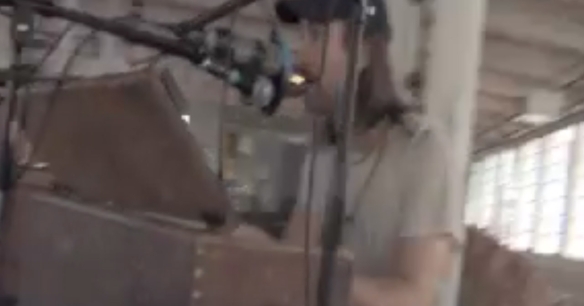The Low Anthem offers work meant to be held, savored, contemplated, and occasionally stomped along to. The band’s hauntingly beautiful 2009 Nonesuch debut, Oh My God, Charlie Darwin, was followed in 2011 by Smart Flesh, the majority of which was recorded in a cavernous, vacant pasta sauce factory, using an eclectic array of instruments, like jaw harp, musical saw, stylophone, antique pump organs, and oversized drum kits. The album's themes include love, longing, and the vain contortions of our lives before death.
“The building didn’t hold heat at all. It was too cold for fast chops and too cold to relax,” recalls Ben Knox Miller, who, with the rest of The Low Anthem, hunkered down in December of 2009 for a winter of recording in a cavernous, derelict pasta sauce factory in Central Falls, RI. Miller, with band-mates Jeff Prystowsky, Jocie Adams, and newest member, Mat Davidson, teamed up with engineer Jesse Lauter to construct a studio in the disused space. They played a wide variety of often unusual instruments, combining folk with blues, hymnals, barn-stompers and whispered meditations to create Smart Flesh, their third record, released on February 22, 2011.
Smart Flesh was self-produced by the band, mixed largely by Mike Mogis (Bright Eyes, Monsters of Folk), and mastered by Bob Ludwig. The record features recordings of older tour staples “Ghost Woman Blues” and “Golden Cattle,” along with new songs such as “Love and Altar” and “Boeing 737.” Having toured for two years since their last album Oh My God, Charlie Darwin, the band had plenty of time to write songs, experiment with arrangements, and day-dream the scope of this recording project. What they had in mind was a massive undertaking. Ten days were spent hauling furniture, gear, carpet scraps, and cabling to prepare the 40,000 square feet of vacant factory to be both a home and a recording instrument for Smart Flesh—all that before a single note was played. Paranormal hitchhikers, taught highwires, aircraft, swelling tumors, whirring machinery, deserted highways, mannequins, cremation, and formaldehyde make up the language of Smart Flesh. The album’s heroes, if there be heroes, are wiremen and lovers—reckless dreamers turning vain contortions in the swill of death.
Oh My God, Charlie Darwin, the band’s previous album, was recorded in January of 2008 in an empty summer cabin on Block Island, RI, and originally self-released by the band that September in true DIY style (the band hand-painted and silkscreened all 2,000 of the first run of the CD packages). Despite having no distribution, booking agent, or publicist, Charlie Darwin was received enthusiastically and the band toured steadily on the strength of word of mouth. The independent success of this album led to record deals in the UK with Bella Union and in the US with Nonesuch, which re-released Oh My God, Charlie Darwin in June 2009. Growing steadily over the past two years, the band has toured with artists ranging from Iron & Wine to Emmylou Harris and The National to The Avett Brothers and Ray Lamontagne. They also played numerous festivals including Bonnaroo, Glastonbury, Newport Folk, Lollapalloza, and Prospect Park’s Celebrate Brooklyn. At the end of 2009, Oh My God, Charlie Darwin was listed in the top of many music publications’ best of year lists and the band picked up MOJO’s Breakthrough Artist Honours award.
The Low Anthem originally met and grew to its current lineup in a handful of ways: Miller (of Ossining, NY) and Prystowsky (of New Jersey) became fast friends sharing graveyard-shift duties as DJs at Brown University’s radio station. With a laughably small listenership, their playlists were primarily for one another. The band became serious for these two when, fresh out of school they teamed up with a gravel-voiced and blues-obsessed Virginian by the name Dan Lefkowitz. The three hatched the beginnings of the band’s sound over nine volatile months together in their Providence apartment, until tensions and divergent interests finally led to Dan’s departure. Bostonian and former NASA technician Jocie Adams soon stepped into the vacancy, after being asked to play clarinet on the final track for their first album, What the Crow Brings. Her fluency with classical composition and arrangement and her intuitive musicality would dramatically expand the band’s horizons. Miller and Prystowsky credit her for being largely responsible for new sense of harmony featured in Oh My God, Charlie Darwin. The band first befriended Mat Davidson (of Roanoke, VA) in these early days gigging in Boston, and in October of 2009 asked him to come on board. Being a versatile multi-instrumentalist and a pure singer, he was a match for their frenetic instrument swapping and harmonic style. Smart Flesh is The Low Anthem’s first recording effort as a quartet.
Along the way, The Low Anthem have not only grown in numbers, they have also added new influences and instruments. After two years of scouring yard sales, attics and eBay while on tour, the band could easily open a second hand music shop, with sufficient peculiarities to be the envy of Brooklyn hipsters and historical preservation societies alike. Most notably they collect and repair antique pump organs, but have also gathered oversized drum kits, hammered dulcimers, autoharps, singing bowls, banjos, steel drums, crotales, horns of all shapes, and a 600 pound pipe organ—they are obsessive scavengers, reverent of oddity and fanatical in the search for sound. The eclectic array of instruments used on Smart Flesh includes jaw harp, musical saw, stylophone, antique organs, and an elaborate scheme to re-amp noise through various chambers of the factory.
It may not be a specific sound they set out for, but they know when they hear it. “We knew right away when we stepped into the factory,” describes Miller. “The space was really the main instrument for the whole record. The resonance was chilling. Everything after that was a secondary instrument—a choice of what tool we used to activate this beautiful instrument that we were inhabiting.” Most of the sound on Smart Flesh is created with organic instruments, though often processed and recaptured through various electronic components. During recording, they were able to place room mics hundreds of feet away to catch the sound barreling across the space, and this boomy distant resonance became a unifying sound for much of the record. They recorded all the noises of the room, intentionally or not, from the wind pressing against the windows to the groaning of the floorboards under their feet.
The mill building once was home to the pasta sauce of infamous and corrupt Providence mayor Buddy Cianci. Its use was donated nearly rent-free by its owners, a company called Hope Artiste Village. After sweeping up the chipped paint blanketing the floors and making peace with the bats flying overhead and other spirits—imagined or not—that shared the space, the band colonized the only three spots warmed by hot air blowers. The southernmost became the recording space, with stations stocked with various families of instruments. The island of warmth in the middle of the room became the engineering and listening “booth.” In the heated pocket by the freight elevator they built a kitchen and living room of couches, bookshelves, hanging plants, and an ever-growing tower of empty pizza boxes.
The place required getting used to: when the tapes were rolling, the buzzing fluorescent lights were killed and the loud, industrial, heat blowers had to be silenced by placing portable space heaters underneath the thermostats (they would automatically turn on if the temperature dropped below 50 degrees). Between takes, a quick game of “baffle-ball” (a tennis derivative, invented by the band) or a bicycle ride around the 40-thousand square foot space would keep a few people warm. Scarves, hats, coats, and long johns were necessary by five o’clock each night as the sunlight faded. “We seem to seek out our own world when we record,” Miller suggests. “Last time, with Darwin, it was an empty island. This time we went to absurd lengths to create an isolated, functioning society. It was self-contained almost with its own rules and systems and transportation routes. That was really fun. We even had an official sport. Everything but waste management. And no cops, except one time. This cop saw Jesse climbing the fire escape and came up after him. Said he looked like a pimp. It was a brief but wonderful little world.”
“It’s such an incredible space sonically. It was surrounded by enormous windows, so they reflected sound. Also, the light was beautiful,” offers Prystowsky. During the day, the low winter sun cast huge plots of light on the wood floor. At night, as the heat of the day retreated through the un-insulated windows, darkness lapped the edges of the glow of table lamps and the space seemed to grow larger around the inhabited islands. “As soon as the sun goes down, you can hardly move your hands in the cold, so your technique changes. You couldn’t play fast.”
“The cold cuts through to your heart, slows your whole body down,” recalls Adams. “It made us focus. Some of our songs got slower. I wanted to create an incubator for my clarinet to keep it from going flat. I never did, but when I was recording ‘Wire,’ we had all of the space heaters around me to keep the clarinet in tune.”
Despite the chill, artists and friends of the band dropped by throughout the recording process to take advantage of the unusual workspace. “An artist would come to paint on the far side, and people would hang out on the couch opposite. We didn’t foresee it that way, but with time, a community was born, and I really looked forward to that every day, going from the apartment where Ben and I were living to what felt like a community art space after a few weeks,” says Prystowsky. Local friends at Nice Slice, the Thayer Street pizza joint, provided free pies daily during the session and Narragansett beer was also donated by the Rhode Island company. Musicians, filmmakers, photographers, and friends of all sorts climbed the fire-escape entrance to the transient camp settled between the thin iron columns of the factory. But there was a primary purpose, and when the tapes were rolling, all other activity would subside, as if the room had been put on pause, to avoid catching unwanted whispers and footsteps.
“We had so many people helping on this record,” says Miller. “So many friends that we’ve met these last few years showed up to be part of it. And of course the gentle bats and the creaking floors and Paul the ghost. There’s a difference in making a record alone to yourself, versus making a record when you have some sense of its community.”
In late February, they said farewell to the pasta sauce factory to head back out on the road. After several months of touring, they revisited the album to record a few additional tracks, this time with live engineer Dan Cardinal, taking their portable setup to build a studio in a Providence garage, nicknamed “the gator pit.” (It had formerly been used as a breeding house for alligators and rare reptiles.) The choice of its small rooms, walled with cement, was an intentional complement to the vastness of the pasta sauce factory. “We had a reverb chamber in the back that had been a walk-in safe, about 10 feet by five. It had this four-and-a-half second delay, as opposed to the factory, which had a bass-y, distant sort of lethargic reverb. You could hear a pre-delay there.” For three weeks, the band camped in this second abandoned flophouse to track several more songs. While the pasta sauce sessions were distinct for their obsessively detailed soundcraft, the gator sessions were relatively relaxed, as the band tried a more casual approach with 10 new songs. Three made the cut, and these combined with the eight surviving songs from the factory to form a album that is hermetic and yet welcoming—as precise as it is enigmatic.
—Graham Smith
